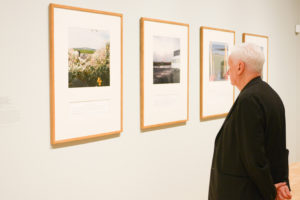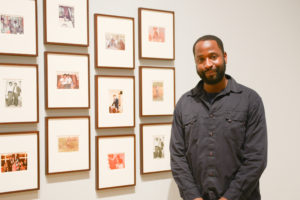Archive: The Artists 2018
Sir Michael Craig-Martin CBE RA (b. 1941)
Irish-British artist, Craig-Martin studied art at the Académie de la Grande Chaumière, Paris, and Yale University. His practice encompasses drawing, painting and conceptual art. He is best known for his images of ordinary objects, with bold outlines and vivid colours. Since 1966 he has lived and worked in London. Craig-Martin was given a knighthood in 2000 and became a Royal Academician in 2006.

Andy Goldsworthy OBE (b. 1956)
Goldsworthy is a British sculptor, photographer and environmentalist. He studied fine art at Bradford College of Art and Preston Polytechnic. For creating his ephemeral, site-specific sculpture and land art he often uses only his bare hands, teeth and found tools. In 2000 he was appointed officer of the Order of the British Empire (OBE) and received the Scottish Arts Council Award in 1987. He lives and works in Scotland.
Christine Hatt (b. 1954)
Born in London, Hatt studied at Ravensbourne and the Slade School of Art. Her abstract work deals with form and perception, in particular repetition, differences and opposites. Though simple in appearance, her works involve a complex layering of materials and colours. In 2007 Hatt was awarded the Jerwood Drawing Prize. She currently lives and works in London.
Runa Islam (b. 1970)
Born in Dhaka, Bangladesh, Islam moved to London at a young age and studied at the Rijksakademie van Beeldende Kunsten, Amsterdam and the Royal College of Art, London. Islam works in the medium of film, investigating the nature of perception and representation. Often employing 16mm film, Islam makes reference to the history of cinematography. In 2008 Islam was nominated for the Turner Prize.
Jasper Johns (b. 1930)
Jasper Johns is an American painter, sculptor and printmaker. He briefly studied at the University of South Carolina, before moving to New York in 1948 to attend Parsons School of Design. His work is associated with abstract expressionism, Neo-Dada and pop art. He is best known for his works of flags, targets and other ordinary objects. Johns received many honours throughout his career, including the National Medal of Arts (1990) and the Presidential Medal of Freedom (2011). Today, he resides between Connecticut and the Caribbean island Saint Martin.
Sir Richard Long CBE RA (b. 1945)
Long studied at Saint Martin’s School of Art from 1966-1968, before going on to create works in various media – sculpture, photography and text. Several of his works are based on walks and land based natural sculpture, which he then maps in photography and text. Long was shortlisted four times for the Turner-Prize and won in 1989. In 2001 he was elected to the Royal Academy of Arts and was given knighthood in January 2018. He was born and still lives in Bristol.
Karl Ohiri (b. 1983)
British-Nigerian artist, Ohiri was born in London and studied Media, Culture and Communications at the University of Greenwich. Ohiri uses photography, text, and everyday objects to engage with social and political themes. His work is also rooted in his personal experiences, exploring dual identity and family relationships. He also works as one half of the collaborative duo Ohiri + Kassinen, whose works were exhibited at the Taylor Wessing Portrait Prize at the National Portrait Gallery, London in 2016-17.

Paul Seawright (b. 1965)
Seawright was born and grew up in Belfast and much of his early work focused on the city’s history. After creating the Sectarian Murder series, for which he is best known, he has made a number of photographic series that centre on conflicts in Africa, America and Afghanistan. In 2002 he was commissioned by the Imperial War Museum, London to create a series of works about 9/11 and its aftermath. Seawright is now Professor of Photography at Ulster University, Belfast, where he also studied.
George Shaw (b. 1966)
Born in Coventry, Shaw completed his training at the Royal College of Art in London in 1998 and is now based in Ilfracombe, Devon. He is noted for his suburban subject matter, mainly focusing on paintings of Tile Hill, a housing estate in Coventry, where he grew up. In 2011 he was nominated for the Turner Prize. From 2014-2016 Shaw was the associate artist of the National Gallery, London.
Wolfgang Tillmans RA (b. 1968)
Born in Remscheid, Germany, Tillmans studied at the Bournemouth and Poole College of Art and Design between 1990-1992. In his photographic practice he focuses on his everyday surroundings, investigating the medium of photography itself. In 2000 Tillmans became the first photographer and non-British person to win the Turner Prize. He has also received a number of other prestigious awards including the Hasselblad Award and the Royal Photographic Society Centenary Medal, both in 2015.
Armando Andrade Tudela (b. 1975)
Born in Lima, Perú, Tudela studied in Lima, London and Maastricht. His practice focuses on the relationship between Modernist aesthetics and local contexts. A founding member of the artist-run space and art collective Espacio La Culpable, in Perú, Tudela has taken part in the 2006 São Paulo Biennial, the 2006 Shanghai Biennial and the 2005 Torino Triennale. He now lives and works in St Etienne, France and Berlin, Germany.
Rachel Whiteread CBE (b. 1963)
Whiteread was born in Ilford, but moved to London at a young age, where she still lives today. From 1985 to 1987 she studied sculpture at the Slade School of Art, London. Her oeuvre primarily consists of sculptures, typically in the form of casts. Many of them are casts of ordinary objects and their so-called negative space. In 1997 she exhibited at the Royal Academy’s Sensation exhibition as one of the Young British Artists. In 1993 she became the first woman to win the Turner Prize.

